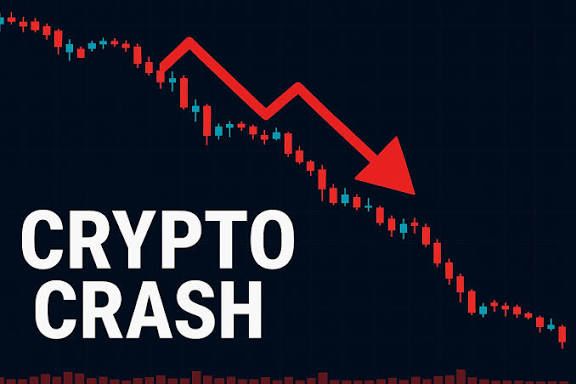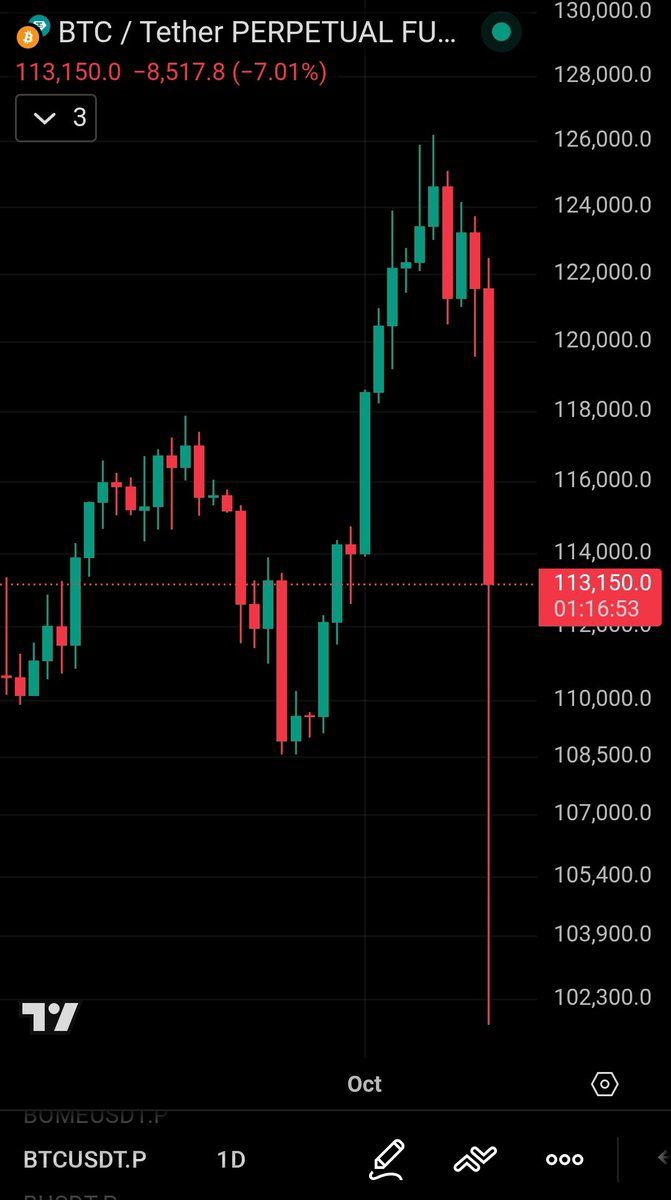
Two days ago, crypto experienced one of its most violent flash crashes in history. About $560 billion (13.1%) came off total crypto market value since October 6, with tokens excluding Bitcoin, Ether and stablecoins falling about 33% in roughly 25 minutes alongside approximately $18.7 billion in liquidations.
Bitcoin tumbled 10% on Friday, while ETH, SOL and XRP crashed 15-30% as trade tensions escalated between the U.S. and China. Over 1.63 million traders were liquidated as longs made up over 85% of the losses.
But here’s what happened next: within 48 hours, Bitcoin recovered from $112K back to the $114-115K range, demonstrating remarkable resilience. As of October 12, BTC is moving sideways near the $114K–$115K range, with some analysts projecting continued consolidation before the next directional move.
This is what a true black swan event, and its aftermath, looks like. Let’s break down what happened, who survived, and what it means for traders on MEXC.
1.The Trigger: Trump’s Trade War Escalation
The catalyst was geopolitical, not crypto-specific. The crypto market crashed after Trump announced aggressive trade measures against China, shocking global markets.
What happened:
October 10, 2025 (Friday morning): President Trump announces severe trade restrictions and potential tariffs on Chinese imports in retaliation for China’s export controls on rare earth metals critical to U.S. technology manufacturing.
Immediate market reaction: Global risk assets plummet as investors flee to safety. U.S. stock futures drop, commodities sell off, and crypto—being the highest-risk asset class—crashes hardest and fastest.
25-minute massacre: The most dramatic selling occurred in a concentrated 25-minute window where altcoins (excluding BTC, ETH, stablecoins) dropped 33%. This speed of collapse caught even experienced traders off guard.
Cascade effect: Leveraged long positions faced massive unrealized losses. Margin calls triggered, forcing automatic liquidations. As liquidations hit the market, they created additional selling pressure, triggering more liquidations in a death spiral.
72-hour journey:
– Oct 10 (Peak): Bitcoin at ~$122K, market relatively calm
– Oct 10 (Flash Crash): Bitcoin plummets to $101-102K low (-17%), ETH crashes from $4,390 to $3,460 (-21%), altcoins -25-40%
– Oct 11 (Recovery begins): Bitcoin bounces back toward $110-112K
– Oct 12 (Current): Bitcoin consolidating $110-115K range, market stabilizing
This textbook black swan event, an unpredictable external shock cascading through interconnected systems, played out and recovered faster than historical precedents.

2.The Numbers: Historic Scale and Speed
Let’s put the damage and recovery into context.
Peak-to-trough destruction:
Total market cap loss: $560 billion (13.1% decline from Oct 6 peak)
Liquidations: $18.7-19.3 billion in forced closures
Traders affected: 1.63 million liquidated
Time frame: Most damage in 25-minute window
Altcoin damage: 33% average decline for non-BTC/ETH/stablecoin assets
Asset-specific carnage:
Bitcoin (BTC):
– Peak: $122K
– Bottom: $101-102K (some exchanges saw $102K, others $104.5K)
– Drop: 77% in under an hour
– Current (Oct 12): $110-115K range (partial recovery)
– Liquidations: ~$8.2B
Ethereum (ETH):
– Peak: $4,390
– Bottom: $3,460
– Drop: **21% peak-to-trough**
– Current projection: Consolidating, eyeing $4,000+ resistance
– Liquidations: ~$5.8B
Major Altcoins (SOL, XRP):
– Drops: 20-40% range in most severe cases
– XRP clawed back from extreme lows toward recovery
– Most severe damage in the concentrated flash crash window
– Slower recovery than BTC/ETH
Long vs Short massacre:
– Longs liquidated: 85%+ ($16.4B+)
– Shorts liquidated: <15% ($2.9B)
The extreme long bias reveals market positioning: traders were overwhelmingly bullish with dangerous leverage levels going into the event.
3.The 25-Minute Collapse: Anatomy of a Flash Crash
The most violent phase lasted just 25 minutes—a concentrated window of destruction that caught most traders unable to react.
The cascade mechanism:
Minute 0-5 (External shock): Trump trade announcement hits wires. Institutional algorithms begin systematic selling across all risk assets.
Minute 5-10 (Initial capitulation): First wave of highly leveraged positions (25x+) hit liquidation thresholds. Exchanges automatically dump these positions into thin order books.
Minute 10-15 (Cascade acceleration): Liquidated positions push prices through multiple support levels. This triggers next tier of liquidations (20x leverage), then next (15x), creating self-reinforcing spiral.
Minute 15-20 (Liquidity vacuum): Altcoin order books completely evaporate. Market makers pull liquidity or widen spreads to 5-10%. Prices gap down through dozens of levels with minimal volume.
Minute 20-25 (Maximum pain): Final liquidation wave hits as even conservative 5-10x leveraged positions reach breaking points. Panic selling peaks as spot holders capitulate.
Minute 25-30 (Stabilization): With leveraged positions mostly cleared and prices at severe discounts, aggressive buyers emerge. Recovery bounce begins almost as violently as the crash.
This entire process, from Trump announcement to stabilization, happened faster than most traders could manually adjust positions, execute trades, or even fully comprehend what was happening.
4.The Recovery: What October 11-12 Revealed
The 48-hour post-crash period is equally instructive as the crash itself.
4.1 Bitcoin’s resilience
Bitcoin’s recovery from the $101-102K flash crash low to the $110-115K range within 48 hours demonstrates remarkable underlying demand strength, though it’s still down 8-10% from pre-crash levels. BTC bounced from its $104K low back up to the $110K–$115K range, showing significant buying interest at deeply discounted levels.
The MACD line is turning upwards slightly, and the histogram is showing a slight recovery with small green bars. This shows a possible short-term bounce, but momentum is still weak.
4.2 Ethereum’s path
ETH recovered more slowly than BTC, typical pattern where altcoins lag Bitcoin in both crashes and recoveries. Ethereum price prediction for October 2025 remains cautiously bullish, with a breakout above $4,500 resistance potentially pushing ETH toward $4,700–$4,900.
4.3 Market structure improvements
Leverage flushed: The liquidation event cleared excessive leverage from the system, reducing future cascade risk.
Stronger hands: Traders who bought the $112K BTC dip and held through volatility are now underwater less or profitable, creating support.
Sentiment reset: Fear & Greed Index displaying a score of 27 (Fear) as of October 12, showing market psychology has recalibrated from excessive optimism.
Institutional buying: Bitcoin has gained over 10 percent in October prior to the crash, peaking at $126,080, with BlackRock accounting for majority of recent ETF inflows showing institutional appetite remains.
5.MEXC Performance: How the Platform Handled Extreme Stress
During the 25-minute flash crash and subsequent volatility, exchange infrastructure quality became life-or-death.
5.1 MEXC’s performance
100% uptime maintained: MEXC’s platform remained fully operational throughout the crash with zero downtime, unlike several competitors that experienced outages, delayed order execution, or complete shutdowns during peak volatility.
Liquidation engine efficiency: MEXC’s liquidation mechanism processed forced closures systematically, though like all exchanges, prices gapped significantly during the liquidity vacuum phase.
Order execution: Market orders experienced severe slippage during the 25-minute window (unavoidable industry-wide), but limit orders placed at strategic levels below market were filled, rewarding prepared traders.
Insurance fund activation: MEXC’s insurance fund absorbed negative balance situations, preventing socialized losses that would have forced all traders to share the burden.
Communication: Real-time platform status updates kept users informed rather than leaving them in the dark during chaos.
5.2 MEXC tools that saved traders
Pre-set stop-losses: Automatically triggered before liquidation levels, limiting losses to predetermined amounts rather than total account wipes.
Take-profit orders: Locked in gains before the crash for traders who had set conservative profit targets.
Liquidation price monitoring: Dashboard clearly showed liquidation levels, allowing rapid margin additions or position reductions.
Multiple order types: Conditional orders and trailing stops helped sophisticated traders navigate volatility programmatically.
Traders who leveraged MEXC’s risk management infrastructure proactively weathered the storm infinitely better than those relying on manual monitoring and reactive decision-making.
6.Winners and Losers: The Wealth Transfer
Black swan events are massive wealth redistributions from the unprepared to the positioned. October 10 was no exception.
Who got destroyed (losers):
Over-leveraged longs (15x+): Completely wiped out. The 17% BTC drop from $122K to $101K triggered liquidations instantly at these leverage levels, with zero chance of recovery.
No-stop-loss traders: Watched helplessly as positions liquidated at worst possible prices with no protective orders in place.
All-in portfolios: Traders with 70%+ capital in single positions had zero ability to average down, hedge, or take defensive action.
Panic sellers: Spot holders who sold BTC at $101-104K absolute bottom, then watched it recover 8-12% to $110-115K within 48 hours, locking in maximum possible losses.
Altcoin maximalists: Those heavily concentrated in altcoins suffered 2-3x worse than BTC-focused portfolios during the 33% altcoin collapse.
Who profited massively (winners):
Short sellers: Traders positioned short before announcement captured the full 17% collapse on BTC ($122K → $101K), 21% on ETH, and up to 40% on select altcoins, generating massive profits in under an hour. One trader famously made $88 million shorting Bitcoin just 30 minutes before the tariff announcement.
Limit order buyers: Patient traders with stacked buy orders at $102-105K BTC, $3,500 ETH got filled at absolute panic bottoms, then rode the 8-12% bounce to $110-115K for substantial quick profits.
Low-leverage holders: Traders using 3-5x leverage or pure spot avoided liquidation, kept positions, and now sit on recovering assets.
Options traders: Put options purchased as portfolio insurance paid out 200-500% during the crash, offsetting spot losses.
Stablecoin accumulators: Traders who had been raising cash in stablecoins during the $120K+ run-up deployed capital at the $101-105K BTC zone, buying a generational dip that recovered 10%+ within 48 hours.
The fundamental lesson: Black swans punish greed and leverage, reward preparation and patience.
7.Market Outlook: October 12 and Beyond
As of October 12, 2025, the market is at a critical juncture, recovery underway but far from certain.
Current state:
Bitcoin: $110-115K consolidation, down 8-10% from $122K peak but recovering from $101K absolute low
Ethereum: Cautiously recovering from $3,460 low, currently consolidating around $3,800-4,000 range
Altcoins: Most still down 20-35% from pre-crash levels, recovering slower than majors
Sentiment: Fear at 27 (down from Greed 70+ before crash)
Liquidations: Greatly reduced as $19.3B in leverage flushed from system
Three scenarios for the next 30 days:
Scenario 1: V-shaped recovery (30% probability)
Catalysts: Trade tensions de-escalate, Fed signals dovish policy, institutional buying accelerates
Price targets: BTC $125-130K, ETH $4,500-5,000
Characteristics: Rapid recovery over 2-3 weeks, altcoins catch up to BTC/ETH performance
Scenario 2: Gradual bottoming process (50% probability)
Catalysts: Trade uncertainty persists, mixed economic data, choppy consolidation
Price targets: BTC $110-120K range-bound, ETH $3,500-4,200 range
Characteristics: Weeks/months of consolidation, multiple retests of support, slow rebuild of confidence
Scenario 3: Lower lows incoming (20% probability)
Catalysts: Trade war escalates, recession signals emerge, crypto-specific negative news
Price targets: BTC $95-105K retest, ETH $2,500-3,000
Characteristics: October 10 was “pre-Black Swan,” real crash still ahead
Market structure favors Scenario 2gradual bottoming with elevated volatility, though Scenario 1 becomes more likely if macro conditions improve.
8.Critical Lessons for MEXC Traders
If you survived October 10 with capital intact, internalize these lessons immediately:
Lesson 1: Leverage is a Double-Edged Sword
Maximum leverage (20x+) guarantees eventual liquidation. Even 10x is dangerous. Conservative leverage (3-5x maximum) or spot holding is the only way to survive black swans consistently.
Lesson 2: Stop-Losses Are Insurance, Not Optional
Stop-losses sometimes get stopped out on noise. But they prevent total liquidation during cascades. October 10 proved this definitively, traders with stops lost 10-20%, traders without stops lost 100%.
Lesson 3: Diversification Reduces Portfolio Shock
If 80% of capital was in altcoins, you suffered 2-3x worse than diversified portfolios. Spread risk across: BTC (40%), ETH (30%), quality altcoins (20%), stablecoins (10%).
Lesson 4: Always Know Your Liquidation Price
MEXC shows liquidation prices clearly. If liquidation is <15% away, reduce position or add margin before volatility strikes, not during.
Lesson 5: Keep 20-30% Dry Powder
Traders with stablecoin reserves bought the $112K BTC dip and made 3-5% in 48 hours. Always maintain cash for opportunities,they arrive when you least expect them.
Lesson 6: Platform Stability Matters
MEXC’s 100% uptime during the crash meant users could execute trades. Competing platforms with outages left users helpless. Platform selection is risk management.
9.Trading Strategy for October 12 and Forward
Here’s a framework for navigating post-black swan market conditions:
For the next 7-14 days:
Reduce position sizes 30-50% until volatility normalizes and market direction clarifies
Widen stop-losses to give positions breathing room; tight stops will get hunted in elevated volatility
Use limit orders exclusively to avoid terrible market order fills during volatility spikes
Monitor trade news closely as Trump/China developments will drive next major moves
Take profits at 3-5% gains rather than holding for 10-20%; in volatile conditions, realized profits beat paper gains
For the next 1-3 months:
Dollar-cost average back in if bullish long-term; don’t try to time one perfect entry
Maintain 25%+ stablecoin reserves for future crash opportunities (they will come)
Watch funding rates for extremes; when shorts pay longs heavily (negative funding), it signals capitulation and potential reversal
Track liquidation clusters visible on MEXC and other platforms; these become magnetic price levels
Build positions in quality projects during fear periods; Bitcoin at $114K might look cheap at $140K in six months
10.The Bottom Line: Survival Equals Success
If your MEXC account survived October 10 intact, you succeeded. Capital preservation during black swans is victoryz profits come later.
Key takeaways:
Black swans are inevitable, not predictable – October 10 won’t be the last external shock to crash crypto markets violently.
Leverage magnifies both gains and destruction – Conservative or zero leverage is the only guaranteed survival strategy during cascades.
MEXC’s infrastructure performed – Platform uptime, liquidation management, and risk tools all functioned under maximum stress when others failed.
Recovery came fast – From $112K to $114-115K in 48 hours shows crypto’s resilience and buyer demand at discounted levels.
Preparation beats prediction – You can’t forecast when black swans strike, but stop-losses, diversification, and conservative leverage ensure survival.
Fear creates opportunity – Traders with capital and discipline bought generational dips and profited within days while others panicked.
The crypto market absorbed $560 billion in losses in 25 minutes and not only survived but partially recovered within 48 hours. That structural resilience, while painful, is actually bullish long-term. Markets that survive black swans emerge stronger with weaker hands shaken out.
For MEXC traders, the platform provided critical infrastructure during chaos, uptime when others went dark, execution when others froze, risk tools when they mattered most. Going forward, using these tools proactively rather than reactively is the difference between surviving the next black swan and becoming another liquidation statistic.
October 10, 2025 will be studied for years as a case study in leverage risk, market structure, and the importance of preparation. Those who learned from it will thrive.
Disclaimer: This content is for educational and reference purposes only and does not constitute any investment advice. Digital asset investments carry high risk. Please evaluate carefully and assume full responsibility for your own decisions.
Join MEXC and Get up to $10,000 Bonus!



